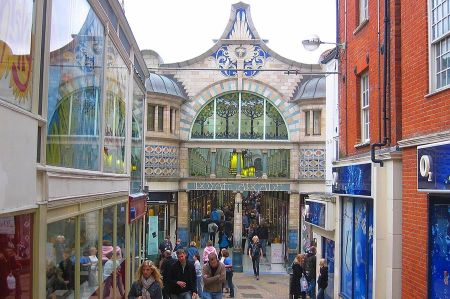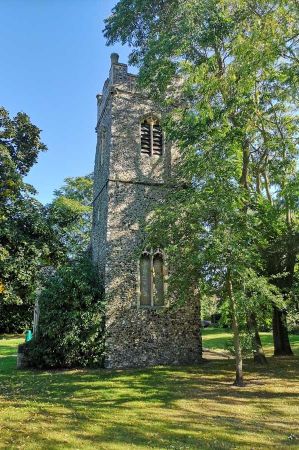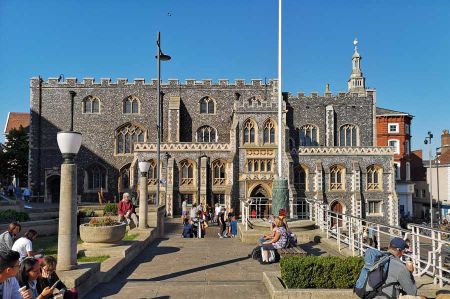A first visit to Norwich - it will not be the last!
- Written by Portal Editor
The city of Norwich, about 100 miles northeast of London, is arguably the most fully preserved medieval city in the United Kingdom, so at least was our impression after a first sightseeing tour.
It features cobbled streets such as Elm Hill, Timber Hill and Tombland, old buildings such as St. Andrews Hall, redesigned half-timbered houses such as Dragon Hall, The Guildhall and Strangers' Hall, Art Nouveau elements of the Royal Arcade of 1899, many medieval streets and the winding River Wensum, which flows through the city center towards Norwich Castle.
What makes Norfolk so attractive - short and compact!

The small town character despite 190,000 inhabitants with an old market square near the town hall and the Forum, which is considered to be the oldest and largest street market in England. The Royal Arcade shopping arcade is worth seeing with its entrance design in Victorian Art Nouveau. (Photo by Layla de Chabot)
The "Riverside Entertainment Complex" entertainment district was built on the river bank near the train station, which includes cinemas, restaurants and shops.
The Millennium Library (called 'The Forum') on the market square, a complex made of glass and steel, houses the city's public library as well as the Tourist Information Centre, the BBC's regional studios and restaurants.
And if you want to explore the city and the surrounding area by bike, these tours are recommended"
The city has two colleges, the University of East Anglia and Norwich University of the Arts, which enliven numerous street students, two cathedrals, Norwich Cathedral and St John the Baptist Cathedral complete the picture. Norwich also has the largest permanent undercover market in Europe, in short a worth visiting city and once again far too short our stay.
Some facts about the history of Norwich

The original capital of the Iceni tribe was initially a settlement near the village of Caistor St. Edmund on the River Tas, about 8 km south of today's Norwich. After a rebellion led by Boudica around 60 AD, the Caistor area became the Roman capital of East Anglia with the name Venta Icenorum, literally "the marketplace of the Iceni".
The Roman settlement fell into oblivion in around 450, and the Anglo-Saxons settled on the site of the modern city between the 5th and 7th centuries, founding the towns of Northwic (named after Norwich), Westwic (in Norwich-over-the-Netherlands) and the secondary settlement at Thorpe.
According to a local rhyme, the decline of Venta Icenorum led to the development of Norwich: "Caistor was a city when Norwich was built from Caistor stone."
The Norwich Castle and its influence on urban development
In 1096, Herbert de Losinga, Bishop of Thetford, began building the Norwich Cathedral. The main building material for the cathedral was limestone, which was imported from Caen in Normandy. To transport the block to the construction site, a channel was dug from the river (from the location of today's Pulls Ferry) to the eastern wall.
Herbert de Losinga then moved his seat to where the cathedral of the diocese of Norwich was located. Norwich received a royal charter from Henry II in 1158 and another from Richard the Lionheart in 1194. Following a riot in the city in 1274, Norwich is considered the only complete English city excommunicated by the Pope.
Recent attempts to enhance Norwich's image and market it as a popular tourist destination, as well as a center for science, commerce, culture and the arts, included the renovation of the Norwich Castle Museum and the opening of the forum.
Recent efforts to promote tourism
Norwich promotes its architectural heritage through a collection of notable buildings in Norwich, also known as "Norwich 12". The group consists of: Norwich Castle, Norwich Cathedral, The Great Hospital, St Andrew's Hall and Blackfriars' Hall, The Guildhall, Dragon Hall, The Assembly House, St James Mill, St John the Baptist RC Cathedral, Surrey House, City Hall and The Forum.
Please read as well:
White Cliffs of Dover - the chalk cliffs in front
Calais - Migrantenhafen am Weg nach England
-
-
-
-
-
-
-
-
-
-
-
-
-
-
-
https://www.alaturka.info/en/actual-cultural-events/4921-a-first-visit-to-norwich-it-will-not-be-the-last/amp#sigProId5984686352
